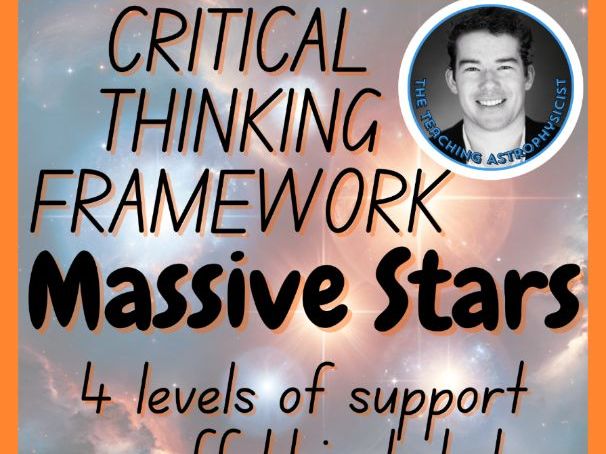

Massive stars are the universe’s heavy lifters, forging the elements that make up planets and life itself. Massive stars extreme gravity and powerful fusion processes produce brilliant light, spectacular supernova explosions, and sometimes even black holes. Teaching students about these stellar giants highlights the interconnectedness of cosmic events, deepening their appreciation for how our own existence ties back to stellar evolution. By exploring massive stars, learners gain insight into fundamental astrophysical processes and the dynamic nature of the universe. With this in mind, let’s engage with this excellent learning and teaching resource.
A critical thinking framework focused on massive stars brings this complex phenomena into clear, student-friendly steps. By guiding learners to identify questions, evaluate evidence, and compare multiple explanations, it transforms the study of these massive stars into an engaging, inquiry-based experience. Students gain a deeper appreciation for science as they piece together how stellar masses and life cycles shape the universe around us. Rather than just memorizing facts, they actively practice scientific habits of mind—analyzing data, identifying gaps in knowledge, and reflecting on the learning process.
A dedicated framework also saves time and supports more robust learning outcomes. It provides a structured path for teachers to implement discussions, projects, or small-group investigations without having to create all the resources from scratch. Embedded prompts and example strategies help students build confidence in their ability to think like scientists, meaning you can focus on facilitating exploration rather than constantly reinventing lesson plans. Ultimately, investing in this streamlined approach helps elevate student engagement, fosters critical thinking skills, and brings the wonders of massive stars to life in the classroom.
THIS MASSIVE STARS CRITICAL THINKING FRAMEWORK CAN BE USED SO MANY WAYS:
- Guided Inquiry Projects: Assign each step as a stage in a research project, from forming a question to reflecting on findings.
- Group Discussions: Facilitate structured group dialogues where each student is the primary driver to one step of the framework.
- Problem-Solving Stations: Set up stations, each focusing on a different step (e.g., analyzing reasoning, identifying limitations), and rotate groups through them.
- Reflection Journals: Encourage students to write short entries on each step after exploring new content or completing a project.
- Peer Teaching: Have students create mini-lessons using the steps, culminating in an elevator pitch or summary to teach classmates.
- Assessment Tool: Use the framework’s steps as a rubric to evaluate the depth and clarity of students’ scientific reasoning and presentations.
Something went wrong, please try again later.
This resource hasn't been reviewed yet
To ensure quality for our reviews, only customers who have purchased this resource can review it
to let us know if it violates our terms and conditions.
Our customer service team will review your report and will be in touch.